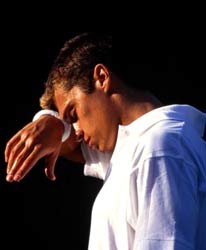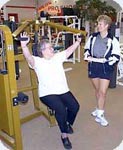|  As
the weather changes from winter to summer we are seeing that many
are down with various kinds of infections and fever. It is important
that food intake is not neglected at this time. We are aware that
when a child or person is ill they are very fussy about their food
and keep refusing to eat. As
the weather changes from winter to summer we are seeing that many
are down with various kinds of infections and fever. It is important
that food intake is not neglected at this time. We are aware that
when a child or person is ill they are very fussy about their food
and keep refusing to eat.
This makes them
very weak and usually we see that they keep falling ill repeatedly
thereafter. One of the most important factors to be considered while
feeding a child with a fever is the timing of giving a feed. If
milk or food is given when the temperature is rising, the child
may refuse to eat, may vomit what he eats or if he does eat it,
it would cause the fever to rise higher.
Milk or any
food must be given only 45 minutes to one hour after a dose of paracetamol
has been given and one sees the temperature coming down. All fatty
foods should be restricted as they are difficult to digest and may
cause the fever to rise higher. When the fever is very high (first
2-3 days) milk should be diluted 2/3 milk to 1/3 water. Rice kanji
with curd or thin dhal and mashed vegetables, fruits and fruit juices
may be given. Small frequent feeds are advisable. Light biscuits
like marie, arrowroot or monaco salt, rusk, toast, etc. can be given
frequently along with milk or as snacks in-between to provide more
energy. Jam, jelly and custard are also helpful in increasing energy
intake. It is also very important to give a morning and evening
dose of B and C vitamin during a fever.
During a fever
the body temperature is high. This raises the metabolic rate of
the body and one tends to burn much more calories. This is the reason
why we see a quick weight loss during a fever and this also makes
the body very weak and susceptible to further infections. To protect
against this our mission in feeding must be to supply a high calorie
diet which is however low in fat content. This can be achieved by
giving small frequent feeds of carbohydrate foods. Jam/honey and
toast is one of the best options, light biscuits, rice and curd
or rice and rasam, rice or rava kanjee or porridges and plenty of
fruits, fruit juices and vegetable soups must be consumed whenever
possible. I have personally followed this and tried this with my
three children and have visibly seen very quick recovery when committed
effort was made to keep the carbohydrate intake as frequent and
as high as possible.
This is not
easy as appetite is low but here it helps if we take a B complex
supplement. Also when ill the tongue gets coated and there is no
taste in the mouth. Keeping the tongue clean and mouth fresh helps
to keep the appetite up.
Glucose may be used instead of sugar to sweeten milk and juices
during a fever as it is more quickly and easily absorbed into the
blood stream. The water intake must be increased as large amounts
of fluid are lost when sweating occurs as the fever breaks. The
daily requirement can be any thing between to two and a half to
four liters. Water, tender coconut water, fruit juices and soups
help to meet this need.
 Those
doing regular exercise or children in training camps or coaching
must be made to completely drop all exercise and rest as much as
possible for 2-3 days at least so that calories may be saved and
the body uses these calories to fight the infection and recover. Those
doing regular exercise or children in training camps or coaching
must be made to completely drop all exercise and rest as much as
possible for 2-3 days at least so that calories may be saved and
the body uses these calories to fight the infection and recover.
|